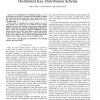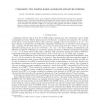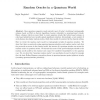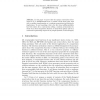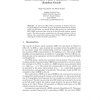CTRSA
2012
Springer
13 years 8 days ago
2012
Springer
We study the problem of searching on encrypted data, where the search is performed using a plaintext message or a keyword, rather than a message-specific trapdoor as done by state...
JOC
2010
14 years 3 months ago
2010
We present a new encryption scheme which is secure against adaptive chosenciphertext attack (or CCA2-secure) in the standard model (i.e. without the use of random oracle). Our sch...
CORR
2000
Springer
14 years 4 months ago
2000
Springer
We take a critical look at the relationship between the security of cryptographic schemes in the Random Oracle Model, and the security of the schemes that result from implementing...
TC
2008
14 years 4 months ago
2008
In a distributed key distribution scheme, a set of servers help a set of users in a group to securely obtain a common key. Security means that an adversary who corrupts some server...
DCC
2010
IEEE
14 years 4 months ago
2010
IEEE
In 2003, Boneh, Gentry, Lynn and Shacham (BGLS) devised the first provably-secure aggregate signature scheme. Their scheme uses bilinear pairings and their security proof is in the...
CORR
2010
Springer
14 years 4 months ago
2010
Springer
Once quantum computers reach maturity most of today's traditional cryptographic schemes based on RSA or discrete logarithms become vulnerable to quantum-based attacks. Hence, ...
EUROCRYPT
2008
Springer
14 years 6 months ago
2008
Springer
Abstract. In this paper we prove that the sponge construction introduced in [4] is indifferentiable from a random oracle when being used with a random transformation or a random pe...
CRYPTO
2008
Springer
14 years 6 months ago
2008
Springer
The Random Oracle Model and the Ideal Cipher Model are two well known idealised models of computation for proving the security of cryptosystems. At Crypto 2005, Coron et al. showed...
CCS
2008
ACM
14 years 6 months ago
2008
ACM
In 1998, Blaze, Bleumer, and Strauss suggested a cryptographic primitive termed proxy re-signature in which a proxy transforms a signature computed under Alice's secret key in...
ASIACRYPT
2006
Springer
14 years 8 months ago
2006
Springer
Abstract. At Eurocrypt 2005, Waters presented an identity based encryption (IBE) protocol which is secure in the full model without random oracle. In this paper, we extend Waters&#...

